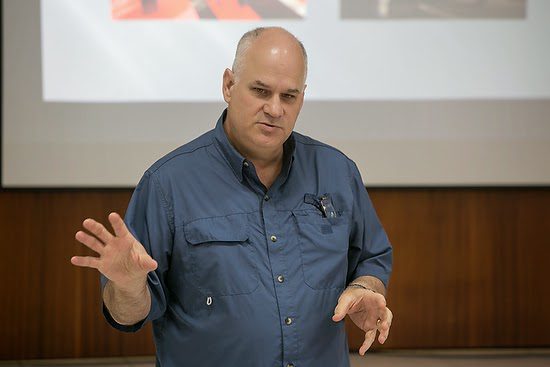| Teaching in Lisbon, Portugal. [photo by Jeff Raymond] |
Synthesizing is the combining of two things for something completely new. For example, I have discovered through the years that combining items in teaching improves my photography.
Storyline
I have discovered that as I came to understand Joseph Campbell’s The Hero’s Journey as a framework for telling stories, I could not only analyze a project and make it better, but I can also apply this storyline to my own life and make changes.
Studying the concept of the storyline helped me do a better job throughout the storytelling process. I did a better job of pre-planning and, amid the shooting of the story, adjusted more quickly and improved the storytelling due to understanding the power of the myth of The Hero’s Journey.
Steve Johnson did a great job a few years ago talking about how synthesis takes place in ideas.
I have enjoyed teaching a lot more than I thought I ever would. I was terrified at first, but over time learned to thrive.
I have shared in many of my past blog posts about how teaching is the highest form of the learning process.
 Combining photography, video, audio, and writing, I have been able to tell stories more effectively than when I was doing photography.
Combining photography, video, audio, and writing, I have been able to tell stories more effectively than when I was doing photography.
When I started to teach, I was perfecting my storytelling skills. First, I had to connect the subject with the audience. Often that audience is just one person. Second, I would have to understand enough about the audience to know how to choose the right metaphors to engage them and teach different complex concepts.
I noticed that when I showed the audience something, their understanding increased over just talking about it. So I was synthesizing [combining] the visual and the spoken word to create a more meaningful and understandable presentation.
I have had many “Aha moments” where what many might consider a failure was a calibrating moment. You try a metaphor and realize this did not work with that audience. You may use it later, but then you must come up with another way to connect with the subject you are trying to teach the audience.
When pros take photos, the first pictures they take in a studio, for example, are to check the exposure, white balance, and often containing a composition. They then look at the photo and analyze it. Does it need to be lighter or darker? Is it too green or magenta? Do I need to do a custom white balance to fix it?
Teaching storytelling has me teaching a variety of subjects. Here are some of the topics I am training, for example:
- Software like Adobe Lightroom, PhotoShop, Adobe Premier, or Final Cut
- Lighting— Hot shoe flashes, studio strobes, radio remotes, flash metering, custom white balance, high-speed sync, slow-speed sync
- Camera — ƒ-stops, aperture, shutter speed, ISO, EV, White Balance, composition, lens choices
- Subjects — Sports, Fashion, Portraiture, Science, Features, Photo Stories, Environmental Portraits, 360º Panoramics, Landscape
- Audio — microphones, setting levels, natural sound, voice over
- Video/motion — formats, audio, storyboarding, scripts
There are more topics, but when I started to teach multimedia storytelling, I synthesized all of them in the class. You cannot teach a subject effectively if you do not know it inside and out. Once the student starts to ask questions about things you haven’t thought about, you must be able to process the inquiry and pull upon all this information to help formulate a response.
When you can answer the student’s questions and help everyone learn, you get invited to teach more and more. You then get exposed to more and more questions which often may have you saying let me get back to you on that question. I might find myself with a camera and working on a solution to the student’s question.
You see, when you teach, you will synthesize the material, and by combining the content, you create new content. As a result, you will start to CREATE new IDEAS. These unique creations will strengthen your portfolio and help you get more work.
Since I don’t always have a class to teach, I use the blog as a way to help me continue to synthesize content and improve my skills. Combining ideas is how you build a better portfolio.
How are you getting better?



